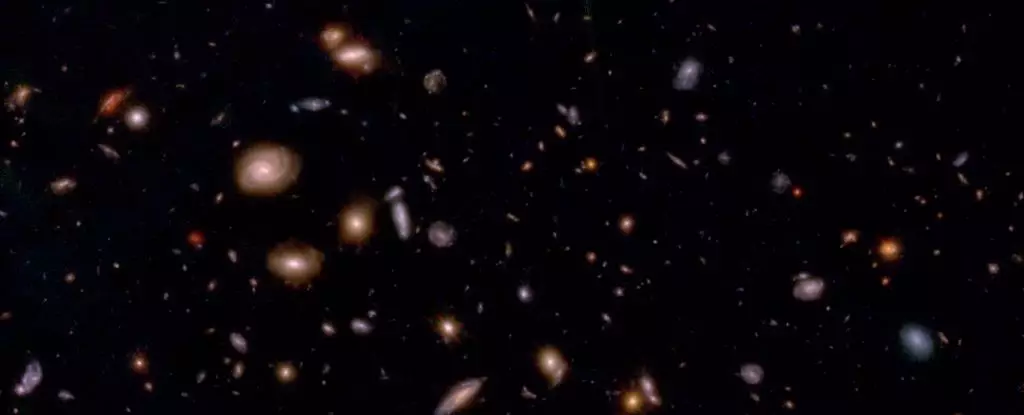Gazing into the boundless expanse of the universe, one might expect to witness sheer chaos—galaxies swirling wildly in infinite directions, their spin dictated by the random forces of cosmic evolution. Yet recent analyses reveal a stunning dissonance between these expectations and the observed reality: galaxies predominantly rotate in the same direction. This puzzling phenomenon ignites a flame of curiosity and challenges fundamental assumptions about the nature of our cosmos. The prevailing understanding of cosmic behavior suggests a hodgepodge of rotations, leading scientists to question if we are overlooking essential aspects of universal dynamics.
Lior Shamir, an astronomer at Kansas State University, brings this conundrum to the forefront, indicating that the unusual alignment of galaxy spins might not be a mere statistical anomaly. Instead, it opens the door to two significant explanations—one more tantalizing than the other. Where did this cosmic rotation stem from? Was the universe born spinning, or is it merely an illusion created by the Milky Way’s own motion influencing our observations?
The Birth of a Rotating Universe?
The first hypothesis posits that the fabric of the universe may have originated with a definitive spin, suggesting a profound modification to existing cosmological theories. This concept aligns with black hole cosmology, wherein the entirety of the universe is considered a vast black hole’s interior. In this framework, the initial rotation may serve as a fundamental characteristic that shaped galaxies over billions of years. Should this interpretation hold any weight, it would signal a significant gap in current theories that fail to account for such fundamental rotational origins.
Furthermore, if this assertion is validated, the implications would be staggering. It not only transforms our understanding of cosmic evolution but also prompts a serious reassessment of how cosmic forces interact to sculpt galaxies. Shamir’s work adds weight to these groundbreaking ideas, revealing an essential aspect of the universe: that its birth might have occurred with an inherent motion, thereby challenging the long-standing notion that cosmic events are explainable through isotropy alone.
Illusions of Motion: The Milky Way’s Influence
Contrastingly, the second explanation diverges into a less enthralling, yet equally provocative territory. This hypothesized illusion suggests that the apparent uniformity in galaxy rotation could be skewed by the perspective of our position within the Milky Way itself. As our home galaxy spins, it may distort the true nature of galaxies beyond our own, leading observers to perceive an orderly rotation where randomness could actually reign. This proposition compels scientists to scrutinize their existing understanding of cosmic observations and methodologies, revealing that even the slightest influences—like the motion of our galaxy—can shape our perception of the universe.
Shamir’s recent studies illuminating 263 galaxies, utilizing data from the James Webb Space Telescope (JWST), present a compelling case for the existence of asymmetries that cannot be written off as mere coincidence. This dataset uncovered a striking discrepancy, with 158 galaxies spinning clockwise versus only 105 that rotate counterclockwise. The simplicity of these findings is misleading; they beckon a deeper analysis of cosmic implications that could redefine the scales of galactic studies and the interpretation of motion across vast distances.
A Call for Reevaluation
What lies at the heart of these contemplative inquiries is not just the statistical analysis itself, but the potential revolution in our understanding of cosmic growth and structure. If the Milky Way’s rotation indeed affects our perceptions of galaxy behavior, as Shamir suggests, this newfound knowledge might compel astronomers to recalibrate their measurements of cosmic distances. Such rectifications could hold the key to solving longstanding problems surrounding the expansion rate of the universe and the mysteries surrounding dark matter and its influence.
This apparent asymmetry in galaxy rotations—while groundbreaking—brings with it a multitude of uncertainties, begging the question of how such phenomena dovetail into the larger framework of astrophysics. As research continues, the narrative of our universe unravels more and more vividly. Each twist and turn reveals the labyrinthine paths that celestial bodies traverse, providing tantalizing glimpses into the mechanisms at work ranging from the birth of the universe itself to the interactions we witness today.
The story of the cosmos, it seems, is far from over. With every observation and hypothesis, we inch closer to understanding the dance of galaxies, revealing not only the observable universe’s complexity but also the very essence of our existence within it.


Leave a Reply